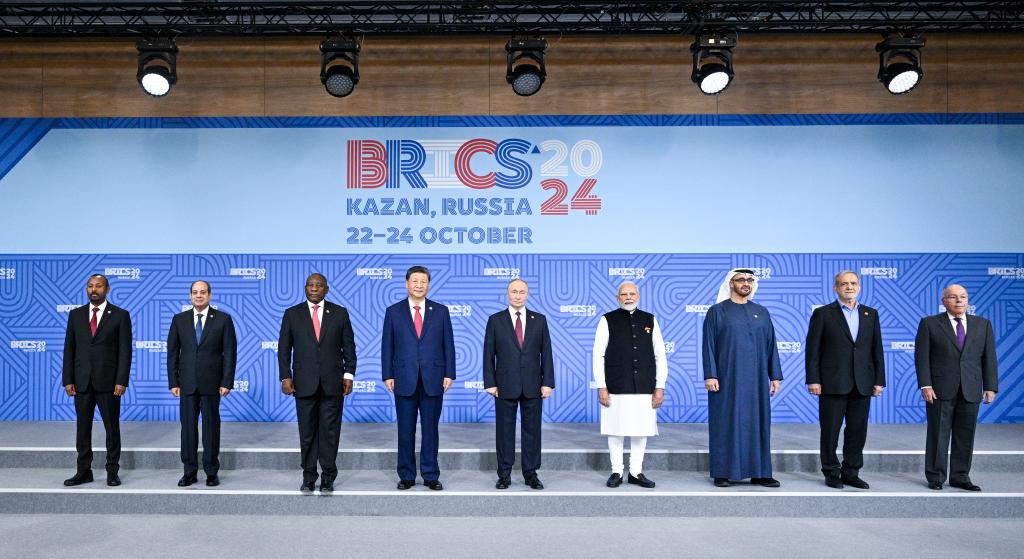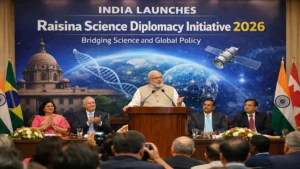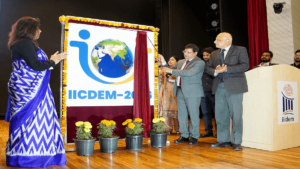The 2024 BRICS Summit, held in Kazan, Russia, from October 22-24, marks a significant turning point for the group as Egypt, Ethiopia, Iran, and the UAE join its ranks following their inclusion at the 2023 summit. The event centers around the theme, “Strengthening Multilateralism for Fair Global Development and Security,” with key discussions on alternative global payment systems, dedollarization, and enhanced cooperation. The summit witnessed the adoption of the BRICS Kazan Declaration, endorsing UN reforms and investigating cross-border financial solutions to reduce reliance on the US dollar.
16th BRICS Summit: Key Outcomes
- BRICS Pay: A new payment system introduced to facilitate financial transactions among member nations, providing an alternative to SWIFT for international settlements.
- Kazan Declaration: Adoption of reforms to the UN, support for Palestine’s full UN membership under the two-state solution, and deliberations on using national currencies for trade.
Key Bilateral Meetings
- China-Russia: Presidents Xi and Putin reaffirmed their strategic partnership, advancing the Belt and Road Initiative and Eurasian Economic Union integration.
- India-China: PM Modi and President Xi resolved a four-year military standoff, aiming to bolster relations between the two ancient civilizations.
- India-Iran: Discussions focused on Chabahar Port, Afghanistan, Central Asia, and the Israel-Palestine conflict.
- Russia-South Africa: President Ramaphosa acknowledged Russia’s support during apartheid, reinforcing their ties.
Global Participation
Leaders from several nations, including South Africa, China, India, and UAE, attended, with Brazilian President Lula da Silva participating online due to health reasons. Other countries such as Armenia, Belarus, and Uzbekistan also sent delegates, contributing to the growing influence of BRICS on global geopolitics.
15th BRICS Summit
The 15th BRICS Summit, held in Johannesburg, marked a significant milestone with the group’s expansion by inviting six new members: Argentina, Egypt, Ethiopia, Iran, Saudi Arabia, and the UAE. The expansion highlights BRICS’ aim to strengthen its global influence and increase representation from the Global South, effective from January 2024. Leaders reaffirmed their commitment to multilateralism, international law, and sustainable development, pushing for reforms in global governance bodies like the UN.
Key Developments
BRICS Expansion and Influence
The summit saw invitations extended to nations across Africa, Latin America, and West Asia, enhancing the group’s geopolitical weight. Over 40 nations have expressed interest in joining BRICS, reflecting the bloc’s growing relevance. The inclusion of energy-rich countries like Saudi Arabia and Iran also bolsters BRICS’ strategic resources.
Common Currency and Space Cooperation
The BRICS leaders agreed to explore the possibility of creating a common currency for trade and investment, aiming to reduce reliance on the US dollar. India proposed the formation of a BRICS space consortium, with particular significance following its successful lunar mission.
India’s Role and Challenges
While India stands to benefit from a more diverse BRICS, it faces challenges, including managing its relationships with China, navigating trade imbalances, and ensuring a balanced approach within the group. India advocates for global governance reforms in the UN and other multilateral organizations, warning that without reforms, these institutions may become obsolete.
A Platform for Global Reform
India, along with other BRICS members, seeks to use the bloc’s expansion to push for broader reforms in global institutions. The expansion sets the stage for BRICS to play a pivotal role in reshaping 21st-century global governance, ensuring that developing nations have a stronger voice on the world stage.
BRICS: Historical Overview and Evolution
Introduction to BRICS
BRICS is an acronym for a group of five major emerging economies: Brazil, Russia, India, China, and South Africa. These nations represent some of the fastest-growing economies in the world and play a significant role in global trade and economic governance. Initially, BRIC (without South Africa) was coined to describe these nations by economist Jim O’Neill in 2001. The grouping later evolved, formally becoming BRICS when South Africa joined in 2010.
Early Formation and the Term “BRIC” (2001-2009)
Origin of the Term “BRIC” (2001)
- In 2001, Jim O’Neill, a British economist at Goldman Sachs, introduced the term “BRIC” to highlight the potential growth of four major emerging economies: Brazil, Russia, India, and China.
- O’Neill believed that these countries would become dominant forces in global economic growth and trade over the coming decades. They were not yet a formal group but were linked due to their size, fast-growing economies, and rising global influence.
Formalization of BRIC (2006)
- The first official meeting between BRIC nations occurred in 2006, on the sidelines of the United Nations General Assembly. The Foreign Ministers of Brazil, Russia, India, and China met to discuss shared interests and common goals.
- This meeting marked the beginning of closer cooperation between these emerging economies, especially regarding economic development, global governance, and political issues.
Formation of BRICS and Expansion (2010)
South Africa Joins BRIC to Form BRICS (2010)
- In 2010, South Africa was invited to join BRIC, transforming it into BRICS.
- South Africa’s inclusion expanded the group’s representation to the African continent, making BRICS a truly global entity covering major emerging economies from four continents: Asia, Africa, Latin America, and Europe.
- The inclusion of South Africa was strategic, as it added diversity and gave BRICS greater influence in international discussions on global development and trade.
Key Objectives and Vision of BRICS
- Economic Growth: The BRICS nations collectively aimed to challenge the Western dominance of global financial systems, particularly the Bretton Woods institutions like the World Bank and the International Monetary Fund (IMF).
- Global Governance Reform: The group advocated for reforming international organizations to give more representation and voice to developing nations.
- Cooperation in Development: BRICS focused on mutual economic, technological, and developmental cooperation, including infrastructure, trade, and investment.
Summits and Milestones in BRICS History
BRICS Summits (2009-present)
BRICS Summits have been held annually since 2009, and each year the group discusses a wide range of issues, including economic policies, global governance, development, and security. Key highlights include:
1st BRICS Summit – Yekaterinburg, Russia (2009)
- This was the inaugural BRICS summit where the four countries (Brazil, Russia, India, China) discussed global economic recovery in the wake of the 2008 financial crisis.
- The summit emphasized reforms in the global financial system to increase the representation of emerging economies.
2nd BRICS Summit – Brasília, Brazil (2010)
- This summit focused on financial cooperation and international trade among BRIC countries, with special emphasis on diversifying their economies and reducing reliance on Western markets.
3rd BRICS Summit – Sanya, China (2011)
- The first summit with South Africa as a full member, marking the transition from BRIC to BRICS.
- Discussions centered on reforming global institutions like the IMF and World Bank and ensuring greater representation for developing nations.
5th BRICS Summit – Durban, South Africa (2013)
- This summit saw the agreement to establish the BRICS New Development Bank (NDB) to finance infrastructure and development projects in BRICS countries and other developing nations.
- The BRICS Contingent Reserve Arrangement (CRA) was also established as a safety net for countries facing balance of payment crises.
6th BRICS Summit – Fortaleza, Brazil (2014)
- The BRICS New Development Bank was officially launched, with its headquarters in Shanghai, China. The bank was seen as an alternative to the Western-dominated World Bank and IMF.
- The NDB was created to focus on infrastructure development, poverty reduction, and sustainable development in developing countries.
9th BRICS Summit – Xiamen, China (2017)
- BRICS introduced the “BRICS Plus” concept, inviting other emerging markets and developing countries to engage with the group. This was part of the effort to expand BRICS’ global outreach and influence.
- Discussions also included topics such as global trade, climate change, and security cooperation.
11th BRICS Summit – Brasília, Brazil (2019)
- Leaders discussed global challenges such as terrorism, trade protectionism, and climate change.
- The summit highlighted the need for increased intra-BRICS cooperation in technology, digital economy, and infrastructure development.
15th BRICS Summit
Expansion and Global Influence
- One of the most significant outcomes of the 2023 summit was the decision to invite six new countries to join BRICS: Argentina, Egypt, Ethiopia, Iran, Saudi Arabia, and the UAE. This move is set to take effect on January 1, 2024, expanding BRICS’ global footprint.
- The summit focused on reforms in multilateral governance, the need for a more inclusive global financial system, and reducing dependence on the US dollar.
Key Focus Areas:
- Multilateralism: BRICS leaders emphasized the importance of a multilateral world order and the need to reform institutions like the United Nations to be more inclusive of emerging economies.
- Common Currency: BRICS discussed the possibility of creating a common currency for trade and investment to reduce reliance on the US dollar.
- Space Cooperation: India proposed a BRICS space exploration consortium, especially following its successful moon landing.
BRICS: Strategic Objectives and Challenges
Strategic Aims:
- Economic Cooperation: BRICS continues to prioritize infrastructure development, economic diversification, and trade among its members and other developing nations.
- Global Financial Reform: The group consistently pushes for reforms in global financial institutions to ensure greater representation for emerging economies.
- Strengthening South-South Cooperation: BRICS aims to enhance collaboration among developing nations in areas such as trade, technology, and innovation.
Challenges Faced by BRICS:
- Internal Disparities: There are vast economic and political differences among BRICS nations, especially between China and India, which pose challenges for collective decision-making.
- Geopolitical Tensions: Border disputes between China and India, as well as Russia’s involvement in the Ukraine conflict, have caused friction within the group.
- Economic Disparities: China’s economic dominance within BRICS has raised concerns about unequal power dynamics within the group.




 India Launches Raisina Science Diplomacy...
India Launches Raisina Science Diplomacy...
 National Textiles Ministers' Conference ...
National Textiles Ministers' Conference ...
 India International Conference on Democr...
India International Conference on Democr...







